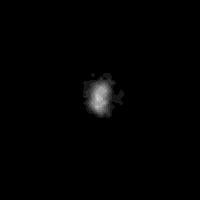 Image of Nereid by Voyager 2 | |
| Discovery | |
|---|---|
| Discovered by | Gerard P. Kuiper[1] |
| Discovery date | May 1, 1949 |
| Periapsis | 1,372,000 km (0.00917 AU) |
| Apoapsis | 9,655,000 km (0.06454 AU) |
| Semi-major axis | 5,513,787 km (0.03685 AU) |
| Eccentricity | 0.7507 (Epoch 2000)[2] 0.7469 (Epoch 2008)[3] |
| Orbital period | 360.1362 d |
| Average orbital speed | 0.934 km/s |
| Inclination | 7.090° to the local Laplace plane (Epoch 2000)[2] 5.05° (Epoch 2008-11-30)[3] 32.55° to Neptune's equator |
| Satellite of | Neptune |
| Physical characteristics | |
| Mean radius | 170±25 km[4] |
| Mass | 3.1 × 1019 kg (assumed)[4] |
| Mean density | 1.5 g/cm3 (assumed)[4] |
| Rotation period | 0.48 d (11 h 31 min)[5] |
| Albedo | 0.155[4] |
| Temperature | ~50 K mean (estimate) |
| | |
Nereid (pronounced /ˈnɪəriɪd/; also /ˈnɛriɪd/, as in Greek Νηρηΐδα),[6] also known as Neptune II, is a moon of Neptune.
Nereid was discovered on 1 May 1949 by Gerard P. Kuiper, who proposed the name in the report of his discovery. It is named after the Nereids, sea-nymphs of Greek mythology.
Nereid was the outermost known moon of Neptune from its discovery until 2002. Nereid's diameter is 340 km, making it the third-largest moon in the Neptune system. Its orbit averages 5,513,400 km in radius, but is highly eccentric and varies from 1,372,000 to 9,655,000 kilometres. This is the highest mean eccentricity of any known satellite in the solar system.[2] But it may lose this title briefly to an outer irregular moon of a gas giant, such as Saturn's Bestla and Uranus' Margaret, because of the Kozai mechanism (a periodic exchange between the inclination and eccentricity).[3] The unusual orbit suggests that it may be a captured asteroid or Kuiper belt object, or that it was perturbed during the capture of Neptune's largest moon Triton.
Halimede may be a fragment of Nereid that was broken off during a collision.[7]
Nereid was too far away from Voyager 2 to be properly imaged when the spacecraft visited the Neptune system in 1989. Photos sent back show only its highly irregular shape, and no surface features could be seen at the resolution available.
0 comments:
Post a Comment